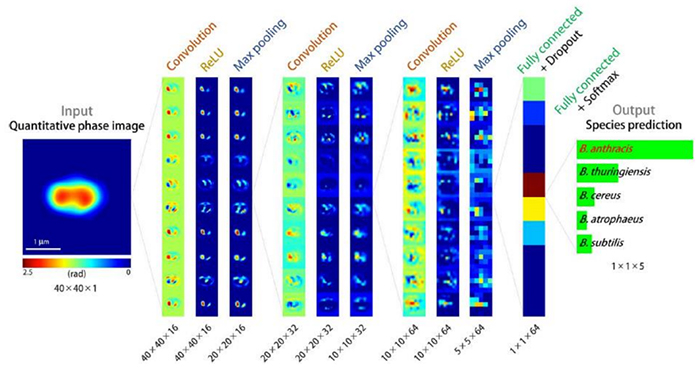A collaboration between KI for Health Science and Technology (KIHST) and the Agency for Defense Development (ADD) developed a rapid biodefense technology to potentially detect anthrax attacks on site. The project was started in 2015 under the leadership of Professor YongKeun Park and Professor Sang Yup Lee, and recently resulted in a publication (YoungJu Jo et al. Science Advances 3(8): e1700606, 04 Aug 2017).
Anthrax spores, or Bacillus anthracis, can be used as biological weapons in biological warfare and bioterrorism. The conventional methods for anthrax detection mostly rely on time-consuming biochemistry techniques that typically require culturing and DNA extraction. These techniques take at least a few hours up to a day to screen for anthrax spores; therefore, there has been a need for faster methods.
The team turned to optics instead of biochemistry, with an aim to remove the time-consuming steps by examining single spores via high-throughput imaging. Holographic microscopy for imaging biological cells and tissues, a technology that was pioneered by Professor Park’s laboratory and recently commercialized by the group’s spin-off company Tomocube, was an ideal tool for this purpose. With the advantages of high- resolution, label-free and scan-less imaging, the technique could be a fast investigation method at the single- spore level. The researchers converted an existing optical microscope to a holographic microscope to conduct imaging of anthrax spores in an isolated laboratory at ADD. The microscope rapidly acquired images of thousands of spores from anthrax and closely-related non-anthrax species.

It was expected that the species-specific information encoded in the holographic images could be exploited for anthrax detection. However, similarities among the species hampered visual inspection, so the team employed artificial intelligence (AI). A deep learning algorithm, which mimics biological visual processing in the brain, was designed, implemented, and trained to classify anthrax and non-anthrax species. Surprisingly, after training, the algorithm distinguished individual spores with high accuracy by actively recognizing the key biological traits encoded in the images.
The proposed technology transforms anthrax detection by tremendously boosting the speed from days to seconds. Scaling up the method by collecting a large number of spore images from various strains would guarantee reliability for use in the field. Moreover, the technique opens the door to a new paradigm for diagnosing infectious pathogens in general; the same pipeline works for various single-cell classification problems, as demonstrated in this study via identifying the human pathogen Listeria monocytogenes.
Park, YongKeun (Dept. of Physics),
Lee, Sang Yup (Dept. of Chemical and Biomolecular Engineering),
Jo, YoungJu (Dept. of Physics)
Homepage: http://bmol.kaist.ac.kr
E-mail: yk.park@kaist.ac.kr






